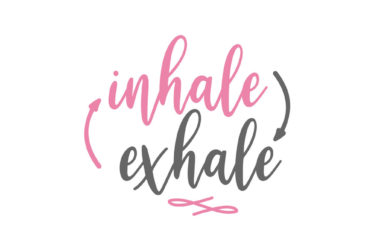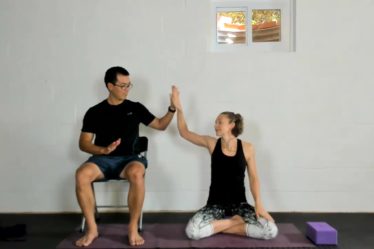
Do we store emotions in our hips?
If you’ve been to more than a handful of yoga classes you’ve probably heard this one. In fact, one of my students asked me this recently, and to be honest, I don’t know. I’ve heard it said by other yoga teachers, and I’ve probably said it myself. Do I have the scientific evidence to back it up? No. Do our bodies reflect and take on our emotions? That one gets a resounding yes from me.
People who have experienced trauma have repetitive movement patterns that offer a sense of protection from the outside world. Shoulders round forward, spine curls in. We close off our chest and our hearts by folding in ourselves. We might even find ourselves in a fetal posture, with knees hugging in towards our chests. We make ourselves as small as possible. If we repeatedly make this shape with our bodies, the bones, the joints, the muscles conform to that posture and associate the shape with certain emotions.
Your experience doesn’t have to be as severe as “trauma” for your body to take note. Are you generally an anxious person? Do you have “worry lines” on your forehead or around your eyes? What is your breathing pattern like when you are anxious? I personally am a chest breather when I’m concerned, and I’m sure my diaphragm has learned this compensation pattern. That pattern also has an effect on my rib cage, my spine, my internal organs, and my abdominal muscles for sure.
Emotions aside, even our daily movement habits influence the posture and shape of our bodies. Do you sit at a desk all day? Are you performing some sort of manual labor? How about an assembly line worker, standing all day, completing a repetitive task?
So, yes, our bodies are a reflection of our lives and our outward experiences. Our emotions and mental state can also deeply affect the shapes our body makes on a regular basis. Do we specifically store emotions in our hips? Meh. I’ll let you be the judge on that one.
Hip Openers
This question however, also leads us to another fun topic: Hip Openers.
The aforementioned student originally asked that question (do we store emotions in our hips) because I think she was looking to release and let go of some feelings/emotions/”ish” and wondered if there were specific postures to help do it (aka: hip openers if emotions are truly stored there). I went into a shorter explanation than the one above and we proceeded to find a few soothing shapes to calm her body and mind. I’m also 100% certain that neither pigeon nor lizard were the poses we settled on — even though I’m guessing that’s what most people think of when I say the word “hip opener.”
In fact, before we can talk about what hip openers really are, we need to finish our discussion about the types of movement available at the hip joint. If you missed Part 1 or Part 2 of this discussion, I highly recommend you read those before forging ahead. They cover the pelvis, what the hip joint is, and the first movement pattern noted in the image below: flexion and extension (spoiler alert and hint: extension is a hip opener!).
Abduction and adduction:
You can see from the image above that abduction is opening the leg out to the side away from the midline of the body, and adduction is “hugging” it in. To remember which is which think about “add”ing two things together. This image depicts the leg moving past the midline in adduction, but that’s a pretty big range of motion. Even squeezing a block between your thighs will work on adduction.
One important thing to note is that the femur (upper leg / thigh bone) needs to stay in a neutral position to isolate this movement to abductor and adductor muscles. What does that mean? Check out the foot in the external rotation image – it’s turned out to the side. In the abduction image the foot is straight ahead – neutral, and not externally rotated.
I see this ALL the time in postures where I’m really trying to ONLY work abduction–side lying leg lifts in pilates are a great example. The foot turns out and our bodies compensate and try to create a wider range of motion. People think that the higher they lift the leg, the “better” they are doing, but in reality they aren’t getting to the intended work of the pose.
Internal and external rotation
When you walk in the snow and then look back at the footprints, what do you notice? Are both feet pointing straight ahead and parallel with each other? Do they make more of a “v” shape with the heels closer together and the toes turned out? Are the toes closer together with the heels turned out?
This is a great way to tell if you naturally have more internal or external rotation. Mine are VERY clearly turned out with a natural inclination towards external rotation. This definitely helps with poses like pigeon and lotus and getting my foot behind my head. However, it makes poses that ask for a neutral position a lot more difficult to maintain. Most backbending postures *should* be attempted with a neutral position. However once I get to my “stopping” point and it gets hard, my body compensates and my toes start to turn out and sometimes the knees go with them. It’s not causing me harm, it’s just something to take note of and work on strengthening those adductors to keep it all in line.
To Be Continued!
I won’t leave you in complete suspense. We covered the different movements availalble to the hip joint so we can at least define what a hip opener is. It is any movement away from the midline of the body: extension, abduction, and/or external rotation. It could be one movement on its own or any combination of the three.
Stay tuned for Part 4 for where we clear up one more confusing cue abou the hips AND a have a deeper discussion about specific hip openers. In the mean time start thinking of some examples of your own based on the definition above – and think outside the box beyond pigeon and lizard!


